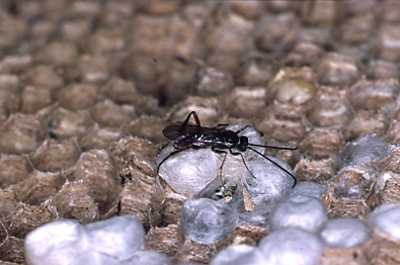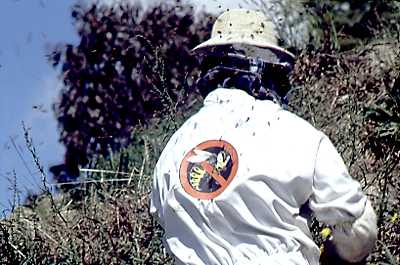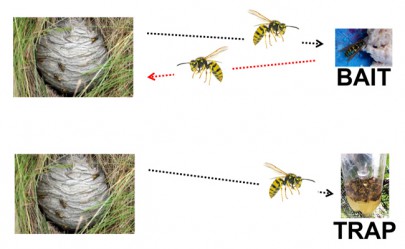Control
In this section
Biological control

Wasp parasitoid searching wasp comb for place to lay eggs.
Biological control is where natural enemies (i.e. biocontrol agents) are utilised to reduce pest numbers. Natural enemies are typically invertebrates and pathogens, and almost always come from the native ‘home’ range of the pest, and therefore need to be imported into New Zealand.
Classical biological control offers a long-term, self-sustaining and environmentally friendly way of reducing wasp numbers. However, wasps would never be eliminated because the control agents depend on wasps for their own survival. We need an organism that will attack wasps and do well in New Zealand conditions but not harm other insects such as honeybees. Finding suitable biological control agents can be a long process because identifying an appropriate agent and screening it to make sure it attacks only wasps can take several years. Once an agent is set free in the environment, it may take many more years to have any noticeable effect.
Some biocontrol agents are less suitable for classical biological control but are more suited for Inundative Biological Control. These agents are usually released in massive numbers and ‘inundate’ the pest, suppressing it numbers. However, these agents generally have trouble in sustaining their large populations, and so need to be re-released at regular intervals.
Invertebrates as Biological Control Agents
In their native range, a Vespula wasp colony is a habitat for a wide range of organisms. Many types of species occur in their nests, some are predators, others feed on remains of dead wasps, some utilise mould or the paper nest structure; others are parasitic. Unfortunately there is very little information on what species attack wasps and even less information on the damage they exert on Vespula.
Sphecophaga
Biological control for wasps in New Zealand has received significant attention with the main focus on parasitoid wasps in the genus Sphecophaga. These are parasitoid wasps that attack the larvae of Vespula wasps (and a few other social wasps), laying their eggs on the outside of the developing larvae and pre-pupa. These eggs develop into larvae and consume the wasp host. Species of Sphecophaga are approximately 5–8 mm in size and are from the family Ichneumonidae (Order: Hymenoptera).
Despite being released at many sites throughout New Zealand, the species Sphecophaga vesparum vesparum, is only known to have established at two sites (Ashley Forest, north of Christchurch, and Pelorus Bridge in Marlborough) and there is no evidence it is reducing wasp numbers.
Other Invertebrates
Several species have been proposed as biocontrol agents against wasps, but few have been thoroughly assessed in terms of their likely impact, or non-target impacts.
The two most promising agents include:
- Hoverflys. Two species of hoverflies (Diptera: Syrphidae) are known to be associated with the nests of Vespid wasps. These hoverflies, Volucella inanis, V. pellucens, are large (1.5 cm), brightly coloured, and relatively common across the UK and Europe. One species, Volucella inanis, seems to be an obligate ectoparasite on vespid wasps; they are very flattened so that they fit into the larval cells beside the wasp larvae on which they feed. Volucella larvae are mostly scavengers during their larval stage but they can be predators of wasp larvae and pupae, especially late in the season.
- Pneumolaelaps mite. Recently in Canterbury, mites have been discovered attached to backs of queen Vespula wasps. The mites have been identified as a species of Pneumolaelaps, but little is known about their biology. Overseas these mites seem to feed on nectar and pollen, and use the bumblebee or wasp nests to overwinter. However, in New Zealand the mites have been observed to feed on wasp larvae and could be responsible for spreading viruses to the wasps. It also seems the mites hitchhike on the back of the queen wasps for dispersal to new areas (an example of phoresy).
The potential for this ‘new discovery’ as a biological control agent is now being assessed with funding from the Sustainable Farming Fund.
Pathogens as Biological Control Agents
Pathogens (agents causing diseases) are a factor regulating many insect populations. For example, research into controlling honeybee diseases is of ongoing importance to the beekeeping industry. Pathogens are also beginning to be used to control social insects such as termites and fire ants.
Previous research has shown that a number of pathogens have been recorded from Vespula nests (and some other related social wasps), including 50 fungal, 12 bacterial, 5–7 nematode, 4 protozoan, and 2 viral species.
To date very few pathogens have been confirmed as actually pathogenic towards wasps, but pathogens remain significant biocontrol option for wasps; perhaps best suited as inundative control agents, or delivered in combination with other natural enemies (e.g. Pneumolaelaps mites, see above).
Wasps have a natural defence against some pathogens. They have antibiotics in their saliva and venom, and can quickly detect and remove infected individuals from the nest before disease spreads. However, it may be possible to overcome this cleaning behaviour by combining chemicals with pathogens.
Research is currently underway at Victoria University examining pathogens of wasps in their native and introduced ranges, and whether the lack of natural enemies results in successful invasion for wasps.
Chemical control
Baiting
Merchento, a Nelson based pest control company, has launched Vespex® ‒ a bait designed specifically for the control of Vespula wasp species.
Vespex® is not attractive to bees, and is of very low risk to birds, pets and people.
Vespex® is only available for sale to persons residing in New Zealand and who are registered with Merchento Ltd as approved users. This is because the bait does contain an ecotoxin, and there are strict stewardship controls in place to ensure that the bait is used in a way that does not present a threat to the environment.
The use of baits has long been recognised as an effective control method for wasps. Worker wasps are attracted to a bait station and feed on a protein food source containing a poison, they then return to their nest spreading the poison around the nest. The advantage of baiting is that you don't have to find and approach nests.
Although baiting is very effective during the current season, in the next season, the area will almost certainly be reinvaded by queen wasps, which can fly many kilometres before establishing a nest. The problem will therefore have to be dealt with each year.
Treating Nest

Waspbuster
Both common and German wasps usually build their nests underground, often in sunny spots or along the banks of streams. Nests are also built in hollow trees and can be found under the floor or in the roof space of houses.
As the entire biology of social wasps is dependent on the nest, direct poisoning of wasp nests is the most effective control method. When a nest is found an insecticidal dust or powder can be used, in which the powder is ‘puffed’ into the entrance of a wasp nest. Worker wasps flying in and out of the nest will spread the powder through the nest, and the colony usually dies within a day.
However, the main problem is finding nests. Wasp nests are usually found by watching for ‘lines of flight’ of worker wasps returning to their nest, or walking along tracks or transects searching for nests. This requires some skill, but can also be quite time consuming. It is also impractical over areas of a certain size.
Several products are registered in New Zealand for use against wasps. These products are available most garden and hardware shops, and from their distributors.
Caution: If you are not confident about destroying a wasp nest do not proceed. Only treat nests that are easily accessible and allow a quick and easy retreat. Do not treat the nest yourself if you think you are allergic to wasps. Use only chemicals that are registered for use in your country and read all labels before use.
- Avoid wet weather as the powder only works as a dry dust.
- All nests should be treated at night when wasps are less active.
- Cover yourself fully with clothing and use a red-covered torch — wasps cannot see red light.
- Approach the nest quietly, and carefully place a spoonful of insecticide in or at the nest entrance or use a puffer bottle to direct the powder into the nest.
- If the nest is disturbed and wasps emerge during treatment quickly retreat and wait for the wasps to settle down before approaching again.
- Don't shine the beam of your torch at the nest entrance for too long as wasps will fly up the beam and possibly sting you.
- Wash your hands and anything else that has touched the powder. Be careful not to breathe any of the dust.
Commercial pest destruction firms will remove nests that are difficult to get at. Your local council may also help, especially if the nest is on council land.
Trapping

The difference between a bait and a trap.
Trapping is when large numbers of wasps (either workers or queens) are lured to a ‘trap’ and killed within it. Placing a traps around an area (e.g. picnic ground) to intercept foraging workers is conceptually simple and appealing. Trapping is also self-fulfilling because ‘dead wasps’ are seen in traps. However, there is no evidence to show trapping is effective, and by itself does not provide area-wide control.
A study in Nelson showed that trapping did not reduce wasp numbers even at individual nests, let alone at the population/landscape level (Spurr 1992). He concluded that trapping is not an effective method of reducing wasp numbers in nearby nests, even when wasp numbers are high.
Other issues with trapping include:
- By-catch or effect on non-target species
Attractants for wasps also attract other insect species (native wasps, flies, moths, weta and beetles). - What life stage should be targeted?
Most research has focused on trapping workers to alleviate problems in public amenities during summer. However, trapping queens could be more appropriate, but only if conducted at the ‘right time’ in their life cycle. Of the large numbers of queens a nest can produce, the vast majority (i.e. 99%) die of natural causes. Of most importance to the life cycle of wasps is the ‘spring flush’, where large numbers of queens come out of their overwintering period, but only very few are successful in starting (and maintaining) a successful nest. Thus, trapping before the ‘spring flush’ occurs (i.e. in autumn or winter) is considered the least successful option of controlling wasps, because it only removes queens that are already likely to die.
Essentially wasps do not have the biological characteristics suitable for mass trapping. Wasps are very fast to reproduce; short-lived; they are widespread and present in high densities. It is unlikely that mass trapping can remove worker wasps fast enough to compensate for the high reproductive output of the nest.
Publications
Ward D 2014. Options for the biological control of Vespula wasps in New Zealand. Landcare Research Contract Report ; LC1684. Landcare Research. 15 p. http://www.envirolink.govt.nz/Envirolink-reports/1-NLCC1/1414-TSDC100/
Ward D 2013. Status of control options for Vespula wasps in New Zealand. Landcare Research contract report ; LC1162. Landcare Research. 48 p. http://www.envirolink.govt.nz/Envirolink-reports/1-NLCC1/1226-TSDC88/
Beggs JR, Rees JS, Toft RJ, Dennis TE, Barlow ND 2008. Evaluating the impact of a biological control parasitoid on invasive Vespula wasps in a natural forest ecosystem. Biological control 44(3): 399–407.
Harris RJ, Etheridge ND 2001/3. Comparison of baits containing fipronil and sulfluramid for the control of Vespula wasps. New Zealand journal of zoology 28(1): 39–48.
Beggs JR, Harris RJ 2000/2. Can the wasp parasitoid Sphecophaga vesparum significantly reduce the density of Vespula wasps? New Zealand journal of zoology 27(1): 73–74.
Rose EAF, Harris RJ, Glare TR 1999/9. Possible pathogens of social wasps (Hymenoptera : Vespidae) and their potential as biological control agents. New Zealand journal of zoology 26(3): 179–190.
Harris R, Read PEC 1999. Enhanced biological control of wasps. Science for conservation. 115. Wellington, Department of Conservation. –38 p
Spurr EB 1996/12. Carbohydrate bait preferences of wasps (Vespula vulgaris and V. germanica) (Hymenoptera: Vespidae) in New Zealand. New Zealand journal of zoology 23(4): 315–324.
Glare TR, Harris RJ, Donovan BJ 1996. Aspergillus flavus as a pathogen of wasps, Vespula spp., in New Zealand. New Zealand journal of zoology 23(4): 339–344.
Spurr EB 1995/2. Protein bait preferences of wasps (Vespula vulgaris and V. germanica) at Mt Thomas, Canterbury, New Zealand. New Zealand journal of zoology 22(3): 281–289.
